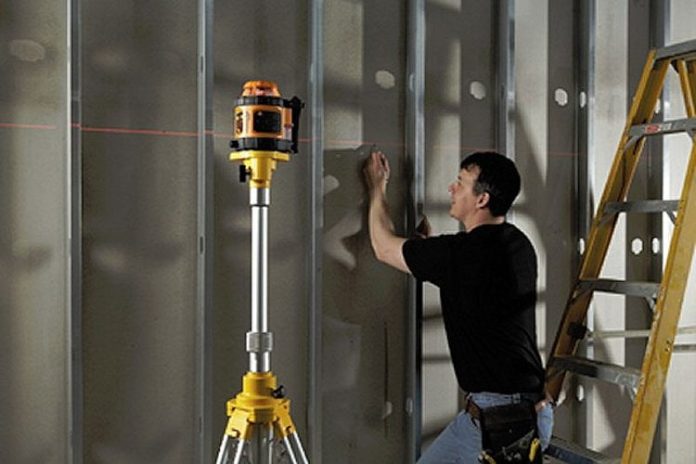A rotary laser can enhance the accuracy and quality of security installation work from horizontal cuts to surface mount conduit, devices, touchscreen, monitor mounts, or equipment cabinets.
It’s a mistake to think of rotary laser’s as only being applicable in very large applications with long cable or trenching runs. Sure, you can measure up from the floor along a line, but a rotary laser makes things much easier.
Other benefits of rotary lasers for security applications is their ability to ensure power cables are buried to the exact depth, or that overhead cabling is undertaken at a specified and standard height.
Rotary lasers comprise 2 parts – a transmitter with tripod that incorporates a spinning laser diode and a receiver mounted on a grade rod, which detects the laser and signals whether it’s level with the beam. Accuracy varies in line with price – some rotary lasers are very expensive – but there are quality units from De Walt and Bosch which are affordable and have excellent accuracy.
Good performance delivers an accuracy variation of around 1.5mm over a distance of 30 metres – that shows you just how useful these devices can be. At closer ranges this performance will be better still and benefits from a capacity to self-level to about 5 degrees. Useful for security installers working in smaller indoor spaces without the receiver, rotary lasers don’t have to be tripod-mounted – they can sit on a table or the floor as well.
The sorts of features and functions you want include variable rotation speeds including 150/300/600/1200rpm – slower speeds can be more accurate in challenging applications. Colour choices include red or green. Green is easier to see but more expensive, and if you’re working outside, you’ll use the grade rod and colour won’t be an issue as you can’t see it in sunlight.
An optional rotation angle including 15/45/90 degrees allows light spill to be controlled in order to improve accuracy by keeping the diode looking where you need it to look. Other things to consider include working range, battery life; user interface, including audible and visual aids; and a robust build quality.
Like any measuring instrument, a rotary laser has delicate components and the addition of a quality carry case and rubber impact protection on receiver and transmitter units will ensure a longer working life. If you find an IP67-rated unit, that’s excellent. You might prefer a Class 3 laser.
Something else to pay attention to include flexible mounting options for times when a tripod is the wrong choice. This might include the addition of magnetic, ceiling or keyhole mounts. Obviously longer warranties are to be preferred – 2 years is good, 3 years is better.
#sen.news #SEN #SENnews











